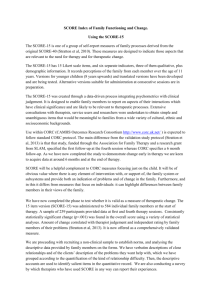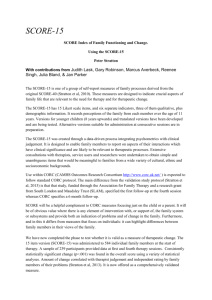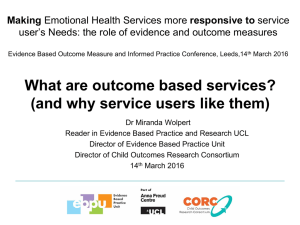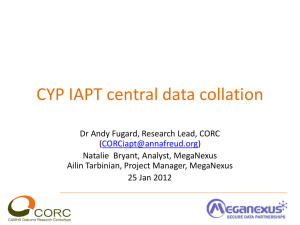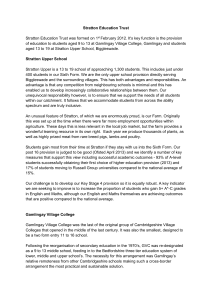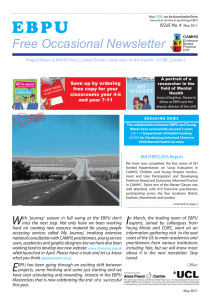SCORE Index of Family Function and Change. Using the SCORE 15
advertisement
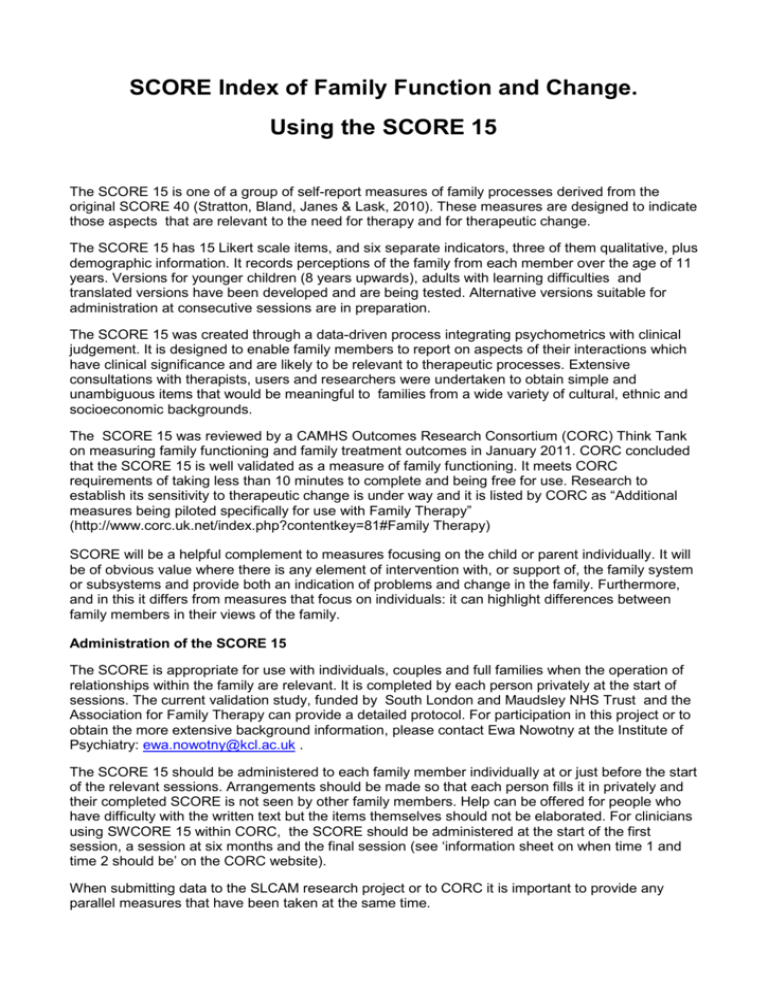
SCORE Index of Family Function and Change. Using the SCORE 15 The SCORE 15 is one of a group of self-report measures of family processes derived from the original SCORE 40 (Stratton, Bland, Janes & Lask, 2010). These measures are designed to indicate those aspects that are relevant to the need for therapy and for therapeutic change. The SCORE 15 has 15 Likert scale items, and six separate indicators, three of them qualitative, plus demographic information. It records perceptions of the family from each member over the age of 11 years. Versions for younger children (8 years upwards), adults with learning difficulties and translated versions have been developed and are being tested. Alternative versions suitable for administration at consecutive sessions are in preparation. The SCORE 15 was created through a data-driven process integrating psychometrics with clinical judgement. It is designed to enable family members to report on aspects of their interactions which have clinical significance and are likely to be relevant to therapeutic processes. Extensive consultations with therapists, users and researchers were undertaken to obtain simple and unambiguous items that would be meaningful to families from a wide variety of cultural, ethnic and socioeconomic backgrounds. The SCORE 15 was reviewed by a CAMHS Outcomes Research Consortium (CORC) Think Tank on measuring family functioning and family treatment outcomes in January 2011. CORC concluded that the SCORE 15 is well validated as a measure of family functioning. It meets CORC requirements of taking less than 10 minutes to complete and being free for use. Research to establish its sensitivity to therapeutic change is under way and it is listed by CORC as “Additional measures being piloted specifically for use with Family Therapy” (http://www.corc.uk.net/index.php?contentkey=81#Family Therapy) SCORE will be a helpful complement to measures focusing on the child or parent individually. It will be of obvious value where there is any element of intervention with, or support of, the family system or subsystems and provide both an indication of problems and change in the family. Furthermore, and in this it differs from measures that focus on individuals: it can highlight differences between family members in their views of the family. Administration of the SCORE 15 The SCORE is appropriate for use with individuals, couples and full families when the operation of relationships within the family are relevant. It is completed by each person privately at the start of sessions. The current validation study, funded by South London and Maudsley NHS Trust and the Association for Family Therapy can provide a detailed protocol. For participation in this project or to obtain the more extensive background information, please contact Ewa Nowotny at the Institute of Psychiatry: ewa.nowotny@kcl.ac.uk . The SCORE 15 should be administered to each family member individually at or just before the start of the relevant sessions. Arrangements should be made so that each person fills it in privately and their completed SCORE is not seen by other family members. Help can be offered for people who have difficulty with the written text but the items themselves should not be elaborated. For clinicians using SWCORE 15 within CORC, the SCORE should be administered at the start of the first session, a session at six months and the final session (see ‘information sheet on when time 1 and time 2 should be’ on the CORC website). When submitting data to the SLCAM research project or to CORC it is important to provide any parallel measures that have been taken at the same time. Scoring and interpretation Calculating the total score A PASW (SPSS) and an Excel spreadsheet are available for entering group data. Contact Professor Peter Stratton p.m.stratton@ntlworld.com for copies and instructions. Individual SCOREs can be coded very simply by hand by working through the following instructions line by line. For the 15 Likert scale items (this method does not require reversing of scores for negative items): Total all negative items - Q2+4+5+7+8+9+11+12+13+14 (with 'very well' as 1 and 'not at all' as 5) Subtract this total from 60 Add the remainder to the total of positive items Q1+3+6+10+15 This gives a total score for each person. Divide by 15 for the average. Scoring Dimensions The SCORE generates three dimensions which can be calculated for more specific information. In each case the total is divided by 5 to give the average, and the lower the score, the higher the functioning.: For Dimension 1, Strengths and adaptability As all of the questions are positive, simply add the scores (Q1+3+6+10+15). For Dimension 2, Overwhelmed by difficulties add all the scores (Q5+7+9+11+14) and then subtract from 30, the remainder is the dimension score. For Dimension 3, Disrupted communication add all the scores (Q2+4+8+12+13) and then subtract from 30, the remainder is the dimension score. The qualitative items are stored as text as Q16description and Q17problem The three analogue scales are Severity of problem Q17rate_a Managing as a family Q17rate_b Helpfulness of therapy Q17rate_c Interpreting scores The potential range of scores is 15 to 75, with a lower score indicating higher family functioning. At this time we are unable to give clinical cut off points because the questionnaire is still being evaluated. Norms for an Irish non-clinical sample will be available in Fay et al, (in press). For further detail see Stratton, P, Bland, J., Janes, E & Lask, J. (2010) . Current updates are on the research page of the AFT website: www.aft.org.uk References Cahill, P. O’Reilly, K, Carr, A, Dooley, B, & Stratton, P. (2010) Validation of a 28-item version of the Systemic Clinical Outcome and Routine Evaluation in an Irish context: The SCORE-28. Journal of Family Therapy. 32, 210-231. Fay et al, (in press), Irish Norms for the SCORE-15 and 28 from a National Telephone Survey. Journal of Family Therapy Stratton, P, Bland, J., Janes, E & Lask, J. (2010) Developing a practicable outcome measure for systemic family therapy: The SCORE. Journal of Family Therapy. 32, 232-258 Stratton, P., McGovern, M., Wetherell, A. and Farrington, C. (2006) Family therapy practitioners researching the reactions of practitioners to an outcome measure. Australian and New Zealand Journal of Family Therapy. 27 pp. 199–207
